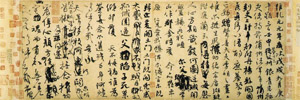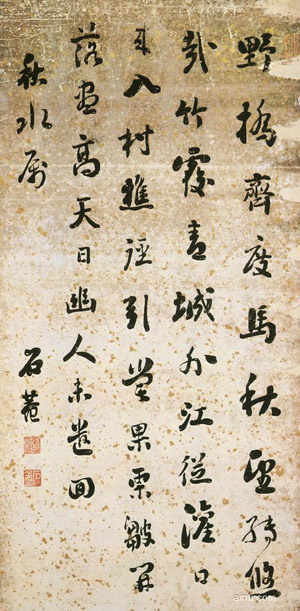Origin and Development of Categories of Calligraphy and Appreciation and Analysis of Calligraphy
Chinese calligraphy consists of five categories of seal script,、clerical script,、cursive script,、
running script and regular script.
Running Script
Running script had already been formed in the late Eastern Han dynasty, reaching its prime in the Eastern Jin dynasty. Its style moderates between regular script and cursive script: it is more free-flowing than the orderly regular script while more easily recognized than the spontaneous cursive script. It was thus widely used. Although running script runs in unrestrained manner, excelling in the writing of this script was not easy. Good practice of regular script is a pre-requisite for fine writing in running script. Wang Xizhi is the most representative personae for the prime age of running script. His Preface to the Orchid Pavilion has been commonly recognized as the prime running script among all. Running script was also common in the Tang dynasty. Yan’s Lament for a Nephew has been commented on as the piece of running second to the Preface to the Orchid Pavilion. For the calligraphy of the Song dynasty, running script made a great achievement. The four major masters of the Song dynasty: Su Shi (1037-1101), Huang Tingjian, Mi Fu and Cai Xiang (1012-1067) were experts at running script. Among calligraphers of the Yuan dynasty, Zhao Mengfu was expert at running script. Some people say that he embodies the essence of calligraphy of earlier generations, particularly benefiting from the father-and-son of Wang Xizhi, influencing the calligraphy circle of the time. Most calligraphers of Ming dynasty were good at running script, including Wen Zhengming and Dong Qichang. Running script of the Qing dynasty was strongly influenced by Zhao Mengfu and Dong Qichang, producing “pavilion form.” In post-Emperor Qianglong’s time, many steles were unearthed. Since then, calligraphy changed its course, for example, Zheng Xie (1693-1766) built in the component of a seal script in running script and modeled a new style. Liu Yong (1720-1804) modeled after Zhao Mengfu and Dong Qichang in an early stage and immersed himself in stele carving in a later stage.
*Selected Works
 |
|
| Lament for a Nephew. Yan Zhengqing, Tang dynasty |
Yan Zhengqing realized that his brother and nephew were killed in the Anshi Riot. He thus wrote this obituary in opulent emotions for his nephew. Power runs through the whole piece and each word relates to one another for continuity. Dryness of the brush occurs at times, releasing pathetic emotion. At the same time, Yan’s running script runs in power and the structure remains solid. His art builds his unique style.
 |
|
| Cold Food Model Calligraphy. Su Shi, Northern Song dynasty |
(Su Shi’s calligraphy inherits traditional art and strikes to revolutionalize from the basic. Cold Food Model Calligraphy includes the two poems Su Shi wrote during the cold food festival in the third year of him being reduced to Huang County. His strokes are strong and properly arranged, changing according to his poetic feelings. The layout changes show unrestrained ups-and-downs. It achieves the seamless merging of artistic form and content.
 |
|
| Chi Du (letter of correspondence). Cai Xiang, Northern Song dynasty |
Cai Xiang drew reference from the calligraphy of the father-and-son of Wang Xizhi in his first approach to calligraphy; he later turned to studying Yan Zhenqing’s calligraphy. His running script is the most amazing. The structural composition is elegant and graceful. Grace is interestingly entwined in the power and freedom. His calligraphy took a significant position in the calligraphy circle in the middle of the northern Song dynasty. The Power of the brushes is solid for this piece of Chi Du while the brushes are steeped in fluidity. Formality of the structure is observed. It is a representative piece of his running script.
 |
|
| Album of Chi Du (letter of correspondence). Zhao Mengfu, Yuan dynasty |
Zhao Mengfu’s cursive script forms its own powerful and glamorous typicality based on the various works of Wang Xizhi including Preface to the Orchid Pavilion.






